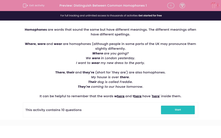Homophones are words that sound the same but have different meanings. The different meanings often have different spellings.
Where, were and wear are homophones (although people in some parts of the UK may pronounce them slightly differently.
Where are you going?
We were in London yesterday.
I want to wear my new dress to the party.
There, their and they're (short for 'they are') are also homophones.
My house is over there.
Their dog is called Freddie.
They're coming to our house tomorrow.
It can be helpful to remember that the words where and there have 'here' inside them.







